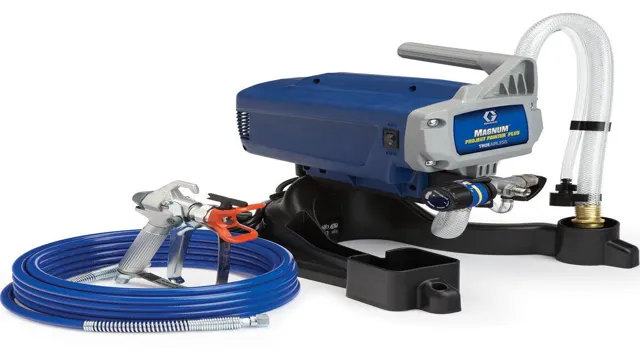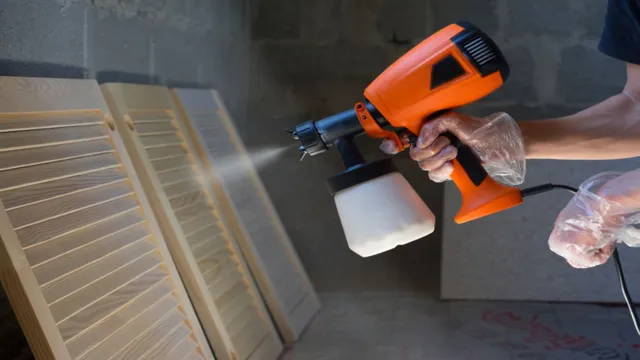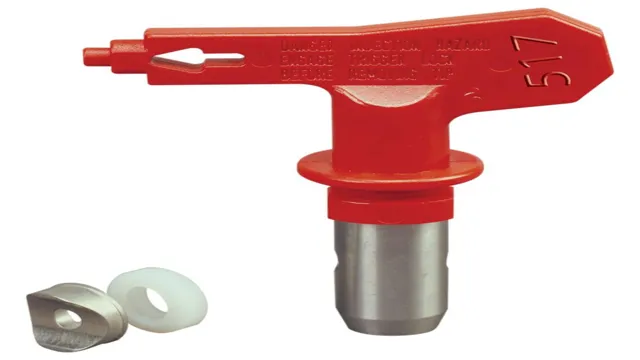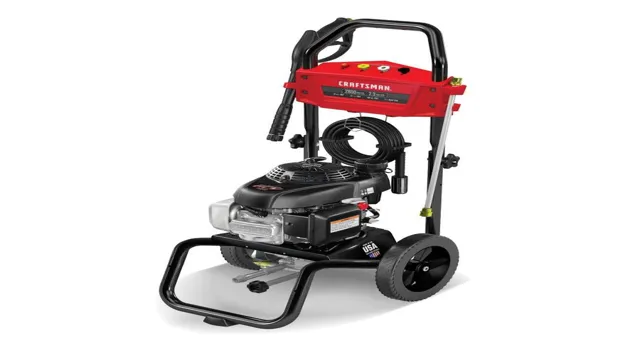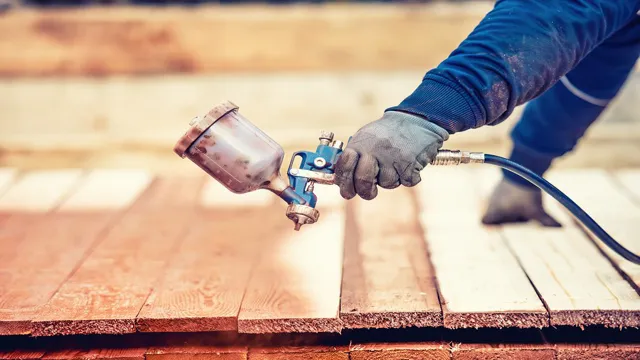Can You Use a Paint Sprayer on Ceilings? Tips and Tricks to Get Professional Results
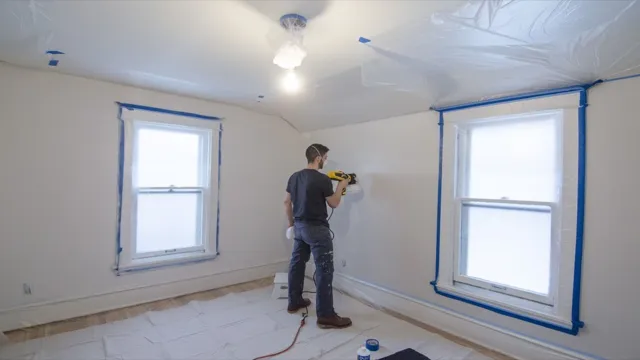
Painting ceilings can be a real pain, especially when trying to achieve a smooth, even finish. But did you know that using a paint sprayer can make the job much easier and faster? By evenly dispersing paint in a fine mist, paint sprayers can save you time and effort while still achieving professional-looking results. But before you start spraying away, it’s important to understand the technique and best practices for using a paint sprayer on ceilings.
In this post, we’ll cover everything you need to know about using a paint sprayer on ceilings, from the tools you’ll need to the proper spraying technique. So, whether you’re a seasoned pro or a first-timer, read on to learn how to get a flawless finish on your ceiling with a paint sprayer.
Understanding Paint Sprayers
Can You Use a Paint Sprayer on Ceilings? Painting ceilings can be a tiresome and time-consuming task for homeowners, but with the use of a paint sprayer, painting large areas such as ceilings has become more comfortable and quicker. A paint sprayer can efficiently apply coats of paint to the ceiling, making it an ideal tool for DIY projects. However, it is essential to consider the type of paint sprayer to use, as some models may not be suitable for ceiling painting.
Airless paint sprayers, for example, are the best option for painting large areas such as ceilings. They offer a consistent and even coverage, which can save you time and money in the long run. Additionally, airless paint sprayers are also ideal for painting textured ceilings, providing an even coat to all the nooks and crannies in the texture.
Overall, using a paint sprayer on ceilings can save you time, effort, and money while providing an excellent finish if done correctly.
Types of Paint Sprayers
Understanding paint sprayers is crucial when undertaking any painting project, whether it’s for your home or a commercial space. There are different types of paint sprayers available, and understanding each type is essential to make an informed decision about which one best suits your needs. Airless paint sprayers, HVLP (High volume low pressure) paint sprayers, and compressed air paint sprayers are the three primary types of paint sprayers.
Each type has its own method of creating and distributing paint, which makes them suitable for various painting jobs. It’s important to consider factors such as the size of the project, type of paint, and level of precision required when selecting a paint sprayer. By evaluating these factors and understanding paint sprayers’ types, you can choose the right one to achieve a professional and polished finish for your project.
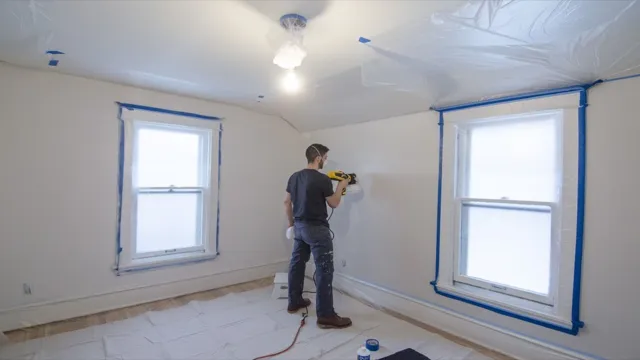
Advantages of Using a Paint Sprayer
Paint sprayers have revolutionized the way we paint surfaces. Understanding paint sprayers is the first step toward discovering the advantages they bring to our painting experiences. A paint sprayer uses compressed air or high pressure to atomize paint, creating a fine mist that is then sprayed onto surfaces.
One of the key advantages of using a paint sprayer is the speed with which paint can be applied. Compared to traditional brushes and rollers, paint sprayers can cover large areas quickly and easily, saving time and effort. Additionally, paint sprayers can provide a smooth and even finish, even on uneven surfaces.
This makes them ideal for texturized walls or surfaces that are tricky to reach with brushes or rollers. Using a paint sprayer also eliminates brush and roller marks, reducing the need for touch-ups and creating a more professional finish. Overall, understanding paint sprayers and their advantages can make painting tasks faster, easier, and more efficient.
Prepping for Ceiling Painting
If you’ve ever painted a ceiling, you know how tedious and time-consuming it can be. But can you use a paint sprayer on ceilings to speed up the process? The answer is yes, you can! In fact, using a paint sprayer on your ceiling can save you a significant amount of time and effort. However, before you start spraying away, there are a few things you need to do to prepare.
First, cover your floors and furniture with drop cloths or plastic sheeting to prevent any paint splatters from ruining your decor. Second, remove any light fixtures or ceiling fans to ensure a smooth and even coat of paint. Finally, make sure to wear protective gear such as goggles and a respirator mask to prevent any harmful paint fumes from entering your lungs.
With these precautions in place, you’ll be ready to tackle your ceiling painting project with a paint sprayer and finish in no time!
Cleaning the Surface
Before you start painting your ceiling, it’s important to properly clean the surface. Dust and debris can accumulate over time, making it difficult for the paint to adhere and causing an uneven finish. First, use a broom or vacuum to remove any loose debris.
Then, wipe the ceiling with a damp cloth or sponge to remove any remaining dirt or dust. If there are any stubborn stains or discoloration, you may need to use a cleaning solution or degreaser. Once the ceiling is clean and dry, you’re ready to start painting.
By taking the time to properly prep the surface, you’ll ensure a professional-looking finish that will last for years to come. So grab your paintbrush and get to work!
Covering Surrounding Areas
When prepping for ceiling painting, it’s essential to consider the surrounding areas of your room. First things first, make sure that all floors, furniture, and decorative items are covered with a drop cloth or plastic sheeting. This will prevent any accidental spills or splatters from damaging these items during the painting process.
Additionally, consider removing any ceiling fixtures, such as ceiling fans or light fixtures, to avoid getting any paint on them. If removing these fixtures isn’t an option, cover them with plastic bags secured with tape. Lastly, use painter’s tape to cover any areas that you don’t want to be painted, such as trim or baseboards.
By taking the extra time to prep your surrounding areas properly, you’ll ensure a clean painting job that won’t cause any accidental damage.
Using a Primer
Using a primer is essential when prepping for ceiling painting. It helps paint adhere better to surfaces and ensures a longer-lasting finish. Before applying the primer, make sure the ceiling is clean and free from any dirt, grime, or grease.
Sand away any rough patches or peeling paint, and fill any cracks or holes with spackle. Apply the primer using a paintbrush or roller, starting from the ceiling’s edges and working inward. A primer allows for a smooth, even coverage and helps seal porous surfaces.
Choosing the right primer is crucial, depending on the surface’s condition and the type of paint you plan to use. Always follow the manufacturer’s instructions and allow the primer to dry completely before applying the paint. By using a primer, you can prevent peeling, cracking, or flaking in the future, ensuring a beautiful and long-lasting finish.
Using a Paint Sprayer on Ceilings
Are you tired of the tedious and time-consuming task of painting ceilings? Well, using a paint sprayer can make the job much faster and easier. But can you use a paint sprayer on ceilings? Absolutely! Paint sprayers can cover large surfaces much quicker than using a brush or roller and provide an even coat with less effort. They work well on textured ceilings as well.
However, it is important to use the right equipment and technique. Make sure you select a sprayer with enough power and a nozzle optimized for ceilings. Begin at the center of the ceiling and work your way out in even strokes, overlapping slightly on each pass for consistent coverage.
A paint sprayer can save you time and hassle, giving you stunning results in no time.
Selecting the Right Sprayer and Nozzle
When it comes to painting ceilings, using a paint sprayer can save you time and effort. But what sprayer and nozzle should you choose? First and foremost, consider the size of the project and the type of paint you’ll be using. For larger projects, an airless paint sprayer may be a better option because it can cover a larger area quicker, while a smaller project may only require a handheld sprayer.
As for the nozzle, a wider tip will give you more coverage on the ceiling, but a narrower tip will provide more precision. It’s also important to use the right pressure setting and ensure proper ventilation in the room. With the right sprayer and nozzle, you’ll be able to tackle your ceiling painting project with ease and efficiency.
Just make sure to take the necessary safety precautions and follow the manufacturer’s instructions for best results.
Spraying Techniques for Ceilings
When it comes to painting ceilings, using a paint sprayer can be a time-saving and efficient option. However, it’s important to consider the technique you use to avoid a messy and uneven finish. One important aspect is choosing the correct nozzle size on your sprayer.
Thicker materials like primers require a larger nozzle size while thinner materials like paint require a smaller one. It’s also important to maintain a steady pace with your sprayer, moving in a consistent motion. It’s best to start at one corner of the ceiling and work your way across in rows, overlapping each pass slightly.
This ensures complete coverage without leaving any gaps or streaks. Overall, using a paint sprayer on ceilings can be a great option for a professional-looking finish with a fraction of the time and effort.
Safety Precautions and Tips
“Can you use a paint sprayer on ceilings?” Yes, you absolutely can! In fact, using a paint sprayer on ceilings can save you a lot of time and effort compared to traditional roller and brush methods. However, it’s important to take the necessary safety precautions before using a paint sprayer. Always wear protective gear such as a respiratory mask, gloves, and goggles to avoid any paint splatters or fumes from causing harm to your eyes, skin, or respiratory system.
It’s also crucial to prepare the area by covering furniture and floors, and using a drop cloth or newspaper to catch any excess paint. Another helpful tip is to use a thicker paint consistency to prevent unwanted drips and splatters. With proper safety measures and a steady hand, you can use a paint sprayer to achieve a smooth and even coat on your ceilings in no time.
Wearing Protective Gear
When it comes to staying safe while enjoying outdoor activities, wearing protective gear is crucial. Whether you are biking, skiing, or participating in any other high-impact sport, protective gear can help prevent injuries and keep you safe. Some essential protective gear includes helmets, knee pads, elbow pads, and wrist guards.
These items can help prevent broken bones and head injuries, which can be life-threatening. It is also important to ensure that your protective gear fits properly and is well-maintained. Taking these safety precautions can make all the difference in keeping you safe while enjoying your favorite outdoor activities.
So next time you hit the slopes or the trails, don’t forget to gear up and stay safe!
Avoiding Over-Spraying and Drips
When it comes to painting, safety should be a top priority to avoid any accidents. One of the most common painting mistakes is over-spraying and leaving drips on the surface. To avoid this, make sure you wear protective gear such as gloves, goggles, and a mask to prevent inhalation of hazardous fumes.
It’s also essential to keep the painting area well-ventilated to avoid suffocation. Additionally, always read and follow the instructions on the paint can to know the recommended spray distance and spray technique. Holding the spray gun too close to the surface or moving it too slowly may result in over-spraying, while moving it too quickly may cause drips.
It’s also vital to clean the spray gun and nozzle after use to prevent buildup and clogging, which can lead to uneven spray patterns and drips. With these safety precautions and tips, you can achieve a smooth and even finish without worrying about any accidents or mistakes.
Proper Maintenance of the Sprayer
When it comes to proper maintenance of your sprayer, safety should be at the top of your priority list. Always read and follow manufacturer instructions carefully and wear appropriate safety gear like gloves, eye protection, and respirators when handling chemicals or cleaning the sprayer. Before starting any maintenance tasks, make sure the sprayer is turned off and disconnected from its power source.
Regularly inspect the sprayer for leaks and worn-out hoses, and replace as necessary. It’s also important to clean the sprayer after every use to prevent buildup and contamination. Using a cleaning solution that’s compatible with the chemicals used with the sprayer is key.
A well-maintained sprayer will not only make your job easier, but it can also prolong the life of your equipment. Remember, taking the time to properly maintain your sprayer now can save you time, money, and even prevent accidents down the line.
Conclusion and Final Thoughts
In conclusion, using a paint sprayer on ceilings is not only possible but can be a game-changer in your painting process. As long as you have the right equipment and take the necessary safety precautions, you’ll be amazed at how quickly and evenly you can get your ceilings looking as fresh as a daisy. So go ahead, grab that sprayer and let your creativity soar – the sky’s the limit!”
FAQs
What is a paint sprayer?
A paint sprayer is a tool that uses air or pressure to spray paint onto a surface, providing a smooth and even finish.
Can you use a paint sprayer on ceilings?
Yes, paint sprayers are ideal for painting ceilings as they can cover large areas quickly and efficiently.
What are the benefits of using a paint sprayer on ceilings?
Using a paint sprayer on ceilings can save time and provide a smoother finish compared to traditional methods such as using rollers or brushes.
What type of paint should be used with a paint sprayer on ceilings?
Thinned latex paint or oil-based paint can be used with a paint sprayer on ceilings.
Is it necessary to cover furniture and floors when using a paint sprayer on ceilings?
Yes, it is recommended to cover furniture and floors with drop cloths or plastic sheeting to protect them from paint overspray.
Can a novice use a paint sprayer on ceilings?
Yes, a novice can use a paint sprayer on ceilings, but it’s important to practice and follow the manufacturer’s instructions carefully.
How do you clean a paint sprayer after using it on ceilings?
Cleaning a paint sprayer after using it on ceilings involves flushing out the paint with water or a cleaning solution and disassembling and cleaning all the parts before storing it.

